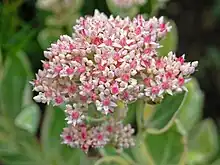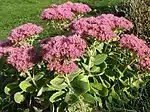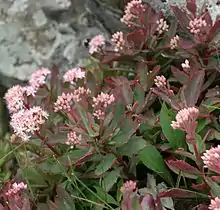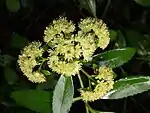Hylotelephium
Hylotelephium is a genus of flowering plants in the stonecrop family Crassulaceae. It includes about 33 species distributed in Asia, Europe, and North America.
| Hylotelephium | |
|---|---|
.jpg.webp) | |
| Hylotelephium spectabile | |
| Scientific classification | |
| Kingdom: | Plantae |
| Clade: | Tracheophytes |
| Clade: | Angiosperms |
| Clade: | Eudicots |
| Order: | Saxifragales |
| Family: | Crassulaceae |
| Subfamily: | Sempervivoideae |
| Genus: | Hylotelephium H.Ohba |
| Type species | |
| Hylotelephium telephium (L.) H.Ohba | |
| Species | |
|
See text | |
Species in the genus, formerly included in Sedum, are popular garden plants, known as sedum, stonecrop, live-for-ever, or orpine. Horticulturalists have hybridized many of the species to create new cultivars. Many of the newer ones are patented, so may not be propagated without a license.
Taxonomy
Hylotelephium telephium and related species have been considered in a number of different ways since first being described by Linnaeus in 1753, including as a section of Sedum by Gray in 1821,[1] or a subgenus. But these taxa are quite distinct from Sedum morphologically.[2]
Hylotelephium is one of a group of genera that form a separate lineage from Sedum, and is closely related to Orostachys, Meterostachys, and Sinocrassula.[3][4]
The separation of the genus has not been universally adopted, for instance a Missouri Botanical Garden website states "Upright Sedums were at one point separated into the genus Hylotelephium, but are now generally included back in the genus Sedum."[5] One of Kew Garden's online databases also lists Hylotelephium as a synonym for Sedum.[6]
Species
The following species are recognised in the genus Hylotelephium:[7]
| Image | Scientific name | Distribution |
|---|---|---|
| Hylotelephium anacampseros | ||
| Hylotelephium angustum | ||
| Hylotelephium × bergeri | ||
| Hylotelephium bonnafousii | ||
| Hylotelephium callichromum | ||
 | Hylotelephium cauticola | Hokkaido, Japan |
| Hylotelephium cyaneum | ||
 | Hylotelephium erythrostictum | Japan, Korea, Russia and China. |
| Hylotelephium ewersii | ||
 | Hylotelephium maximum | |
| Hylotelephium mingjinianum | ||
.jpg.webp) | Hylotelephium pallescens | China, Japan, Korea, Mongolia, Russia |
| Hylotelephium pluricaule | ||
| Hylotelephium populifolium | ||
 | Hylotelephium sieboldii | Japan |
| Hylotelephium sordidum | ||
 | Hylotelephium spectabile | China and Korea. |
| Hylotelephium sukaczevii | ||
| Hylotelephium tatarinowii | ||
 | Hylotelephium telephioides | USA extends from Georgia to Illinois and New York, and it has introduced populations in Ontario. |
 | Hylotelephium telephium | Eurasia. |
| Hylotelephium tianschanicum | ||
| Hylotelephium uralense | ||
| Hylotelephium ussuriense | ||
 | Hylotelephium verticillatum | China, Japan, Korea, Russia |
| Hylotelephium viride | ||
| Hylotelephium viviparum | ||
Hybrids
Etymology
Hylotelephium means 'woodland distant lover'. 'Hylo' is derived from Greek, meaning 'forest' or 'woodland'. 'Telephium', also derived from Greek, means 'distant-lover'; the plant was thought to be able to indicate when one's affections were returned.[8]
References
- Gray 1821.
- Ohba 1977.
- Mayuzumi & Ohba 2004.
- Fu et al 2004.
- MBG 2019.
- POWO 2019.
- "Hylotelephium H.Ohba | Plants of the World Online | Kew Science". Plants of the World Online. Archived from the original on 2022-05-28. Retrieved 2022-07-19.
- Gledhill 2006.
Bibliography
- Gledhill, David (2006). The names of plants (4th ed.). Cambridge: Cambridge University Press. ISBN 0521866456. Archived from the original on 2023-02-08. Retrieved 2023-02-08.
- Gray, Samuel Frederick (1821). "Sedum b. Telephium". A natural arrangement of British plants: according to their relations to each other as pointed out by Jussieu, De Candolle, Brown, &c. 2 vols. London: Baldwin, Cradock, and Joy. pp. ii: 539–540. Archived from the original on 2014-02-24. Retrieved 2023-02-08.
- Thiede, J; Eggli, U (2007). "Crassulaceae". In Kubitzki, Klaus (ed.). Berberidopsidales, Buxales, Crossosomatales, Fabales p.p., Geraniales, Gunnerales, Myrtales p.p., Proteales, Saxifragales, Vitales, Zygophyllales, Clusiaceae Alliance, Passifloraceae Alliance, Dilleniaceae, Huaceae, Picramniaceae, Sabiaceae. pp. 83–119. ISBN 978-3540322146. Archived from the original on 2023-02-08. Retrieved 2023-02-08. (full text at Archived 2020-10-19 at the Wayback Machine ResearchGate)
- Mayuzumi, Shinzo; Ohba, Hideaki (2004). "The Phylogenetic Position of Eastern Asian Sedoideae (Crassulaceae) Inferred from Chloroplast and Nuclear DNA Sequences". Systematic Botany. 29 (3): 587–598. doi:10.1600/0363644041744329. ISSN 0363-6445. JSTOR 25063994. S2CID 84319808.
- Ohba, Hideaki (March 1977). "The taxonomic status of Sedum telephium and its allied species (Crassulaceae)". The Botanical Magazine Tokyo. 90 (1): 41–56. doi:10.1007/BF02489468. S2CID 22239507.
- Fu, Kunjun; Ohba, Hideaki; Gilbert, Michael G. (2004). "Hylotelephium H. Ohba". p. 209. Archived from the original on 12 November 2014. Retrieved 24 August 2019., in Flora of China online vol. 8
- "Sedum 'Purple Emperor'". Plant Finder: Gardening Help. Missouri Botanical Garden. Archived from the original on 27 October 2017. Retrieved 17 October 2019.
- TPL (2013). "The Plant List Version 1.1: Hylotelephium". Royal Botanic Gardens, Kew and Missouri Botanical Garden. Archived from the original on 28 April 2020. Retrieved 1 September 2019.